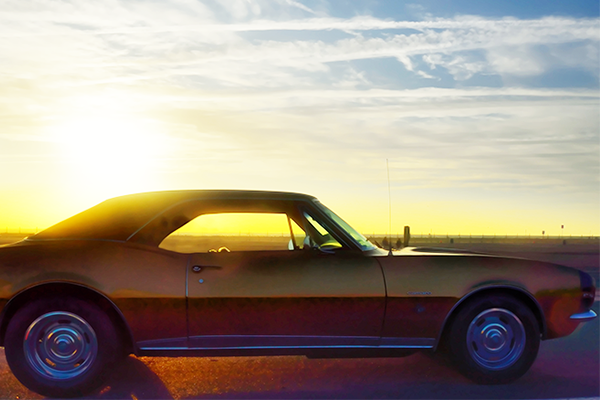From timeless icons to everyday essentials, Crucial Cars examines the vehicles we can’t live without. For this installment, we continue to shine the spotlight on a sports car with a strong, well-deserved fan base – the Mazda RX-7.
Back in the fall of 1978 when Mazda’s RX-7 sports car debuted (for the ‘79 model year), new wave music began shoving disco aside on radio, Space Invaders had kids shoving each other aside in video game centers, and Japanese cars accounted for about half of all new car sales in the U.S.
With its rotary engine and lightweight and agile chassis, the RX-7 was as big a hit with driving enthusiasts as those video games were with teenagers. We’ve already covered the first two generations of the Mazda RX-7, so now with Part Two of this retrospective, we pick up where we left off. 1993 Mazda RX-7
1993 Mazda RX-7
Sleek, Sophisticated, and Speedy
Unveiled for the 1993 model year, the third generation of the Mazda RX-7 was a leap forward in sophistication. With its low, flowing body stretched out over the wheels, the organic form of the newest rotary rocket was a study in how form following function can yield something bordering on motorized sculpture. Mazda had the goal of making the car lighter and more powerful, and it was emphatically met. At about 2,800 pounds, the new Mazda RX-7 weighed over 200 pounds less than a comparably-equipped previous-generation RX-7. And the rotary engine, still measuring just 1.3 liters—but now sporting twin turbochargers—spun out 255 eager horsepower.
This RX-7 was initially offered in three trim levels: the well-equipped base, the luxury-themed Touring, and the hard-core performance R1. For most folks, the base or leather-lined Touring version was ideal, while the stiffly-sprung R1 (and its successor, the R2) was geared towards track-day enthusiasts willing to put up with a harsh ride in exchange for maximum handling performance. In any event, the cockpit was all business, if a little tight for larger folks.
The numbers generated by the third-gen RX-7 were nothing short of stunning. With the ability to hit 60 mph in the low-five-second range and rip down the quarter mile in about 14 seconds flat, this Mazda was as speedy as a Ferrari 348. Yet true to its heritage, the RX-7 really came into its own on a twisty road, where its lightweight, superb balance, athletic chassis and communicative steering made it a blast.
Available in the States for just three model years (1993 through 1995), due to the car's ever increasing price (the result of a strong yen and weak dollar) and resultant decreasing demand, the third-gen RX-7 nonetheless made a big impact on enthusiasts, as well as Mazda’s history book.
The numbers generated by the third-gen RX-7 were nothing short of stunning, with the ability to hit 60 mph in the low-five-second range and rip down the quarter mile in about 14 seconds flat.
Mazda’s Rotary Car Takes a Different Road
After a nearly 10-year hiatus in the states, Mazda’s rotary-powered sports car returned for 2004 with a slightly different name and slightly different mission. Now called the RX-8, the latest version of Mazda’s flagship performance car dropped the turbochargers, gained a functional back seat and emerged as a considerably more practical, if less elegant, sports car choice. 2004 Mazda RX-8
2004 Mazda RX-8
With its higher roofline and bigger cabin, the RX-8 lost much of its former visual pizzazz. But the benefit of its bulkier physique was a much larger interior that allowed a pair of adult-rated seats in the back. Accessed by a pair of reverse-opening rear doors, that rear compartment could comfortably carry a pair of six-footers, an unheard of feat in a genuine sports car.
The complex twin-turbo rotary engine of the previous generation gave way to a redesigned, simpler, naturally-aspirated rotary dubbed “Renesis”. It made a solid 238 hp when matched to the six-speed manual gearbox, and 197 hp when running through the available four-speed automatic. The tach’s redline was marked at an impressive 9,000 rpm.
Although it expectedly gained weight compared to the RX-7, the RX-8 at around 3,030 pounds was still respectably light, especially for a genuine four-seater. Naturally, its acceleration wasn’t quite as thrilling as before. But with a 6.6-second 60 mph time and a 15.1 second quarter-mile performance, it was still swift enough to induce grins, especially once the tach’s needle swung past 5,000 rpm.
Available through 2011, the mostly unchanged RX-8 enjoyed a long run that spanned eight model years. And make no mistake, even with its ability to transport four full-size adults, Mazda’s rotary-powered sports machine was still plenty of fun to drive as it retained the loveable, light-on-its-feet and connected to the driver personality it had since day one.
Mazda RX-7 enthusiasts looking for advice, upcoming events, and classifieds should check out rx7club.comas well as rx7.org.







